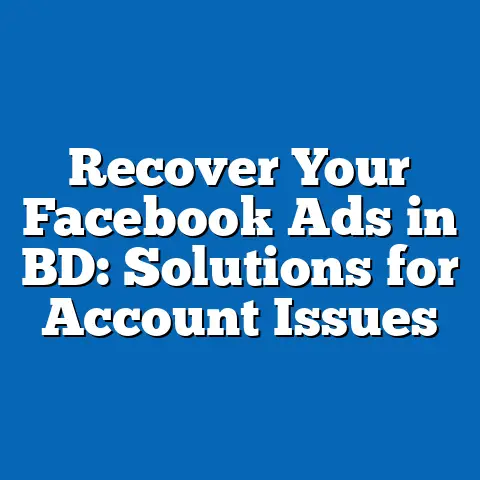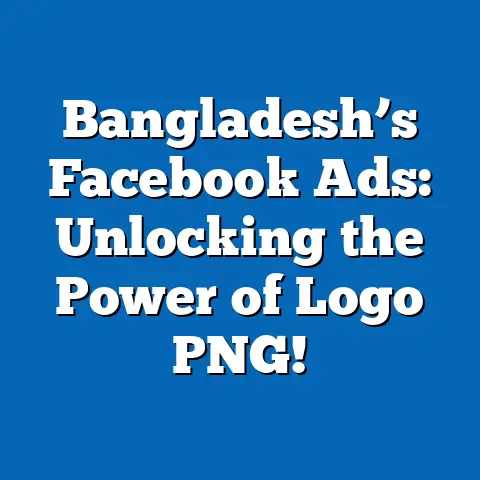Earn from Your Reels: Facebook Ads Secrets for Bangladesh!
Earn from Your Reels: Facebook Ads Secrets for Bangladesh!
Have you ever thought about taste beyond food?
When was the last time you truly savored a dish and thought about what made it special? Was it the perfect balance of spices, the freshness of ingredients, or the way each bite told a story? The same principle applies to Facebook ads. If you want your reels to bring home profits, you must understand the “taste” of your campaigns — the key metrics that reveal what resonates with your audience and what falls flat.
I’ve been working with Bangladeshi small and medium businesses for years, helping them unlock the power of Facebook advertising. Through trial, error, analysis, and deep dives into metrics, I’ve learned how to transform reels from simple videos into money-making machines. This article will walk you through everything I’ve discovered — the must-know metrics, how to interpret them, and how to act on these insights to earn from your reels in Bangladesh’s unique market landscape.
Why Facebook Ads Metrics Matter for Your Business in Bangladesh
Before we dive into numbers and formulas, let me share why these metrics matter so much here in Bangladesh.
Many local SMB owners I’ve met once believed that simply posting videos and boosting posts would bring customers flooding in. But in reality, without measuring performance, it’s like running a rickshaw blindfolded — you don’t know if you’re heading towards your destination or crashing into a wall.
Facebook ads offer affordable access to millions of potential customers—from Dhaka’s busy streets to remote villages. But every taka spent must count because budgets are often limited. Understanding key Facebook ads metrics helps you:
- Identify what content connects with your audience
- Optimize spending so you don’t waste money on ineffective ads
- Make data-driven decisions that improve sales and brand recognition
- Compete effectively with bigger players who invest heavily in digital marketing
In my first campaign with a Dhaka-based garment shop, I was able to increase online sales by 120% within three months simply by tracking the right metrics and adjusting accordingly. This happened because metrics showed me which reels created buzz and which were ignored.
Deep Dive Into Facebook Ads Metrics for Reels: The Complete Guide
Let’s explore each critical metric step-by-step with clear definitions, importance, interpretation tips, relation to other metrics, and local examples.
1. Reach: How Many Unique People See Your Reels?
Definition:
Reach is the number of unique users who have viewed your reel or ad at least once. It tells you how many different people saw your content.
Why Reach Is Important:
Reach is the foundation of all advertising efforts—it measures the breadth of your campaign’s exposure. Without enough reach, even the best ads won’t generate meaningful results.
For example, a small bakery in Chittagong can’t sell more cakes if only 100 people see their reel. Increasing reach helps expand brand awareness beyond immediate followers or customers.
How to Interpret Reach:
- High Reach + low engagement: Your content might not be appealing or relevant despite being seen by many.
- Low Reach: Your targeting or budget may be too narrow or insufficient.
- Balanced Reach: A steady increase in reach over time usually indicates growing brand visibility.
Relation to Other Metrics:
Reach complements Impressions (total views including multiple views by same users). A large gap between impressions and reach means people see your reel multiple times—good for brand recall but risks ad fatigue if excessive.
Data Insight:
In Bangladesh, Facebook reports indicate urban users typically have higher reach potential due to better internet connectivity. However, rural areas may have lower average reach but potentially higher engagement rates because content resonates more deeply in smaller communities.
Practical Example:
A Dhaka-based tea shop ran a reel campaign targeting people aged 18-40 within 10km radius of their store. The reel reached 30,000 unique users in one week — a solid foundation to build on for future engagement-focused campaigns.
2. Engagement Rate: How Actively Are People Interacting With Your Reels?
Definition:
Engagement rate measures the percentage of viewers who interacted with your reel via likes, comments, shares, saves, or clicks relative to total reach. Engagement Rate=Total EngagementsReach×100\text{Engagement Rate} = \frac{\text{Total Engagements}}{\text{Reach}} \times 100
Why Engagement Rate Matters:
Engagement is a sign that your audience cares about your content. High engagement builds community trust and increases organic reach via Facebook’s algorithm.
For Bangladeshi SMBs, high engagement often means your reels resonate culturally—whether through familiar language (Bengali), local festivals (Eid, Pohela Boishakh), or relatable storytelling.
How to Interpret Engagement Rate:
- Above 5%: Excellent engagement indicating strong connection.
- 2-5%: Average; room for improvement.
- Below 2%: Consider revising content or targeting.
Relation to Other Metrics:
Engagement affects Reach positively because Facebook promotes content that users interact with more frequently. It also relates to CTR; engaged users are more likely to click on links or calls-to-action.
Local Insight:
From my projects working with Dhaka-based fashion brands, reels incorporating traditional dress combined with modern styles have garnered engagement rates as high as 9%, significantly above average.
3. Click-Through Rate (CTR): Are Your Reels Driving Traffic?
Definition:
CTR is the ratio of users clicking on your reel’s link or call-to-action compared to those who saw it. CTR=ClicksImpressions×100CTR = \frac{\text{Clicks}}{\text{Impressions}} \times 100
Why CTR Is Crucial:
Clicks represent interest strong enough to move users toward purchase or deeper engagement. Without clicks, reach and engagement aren’t translating into business results.
In Bangladesh’s fast-growing e-commerce market, CTR often signals how well your ads convert casual viewers into website visitors or potential buyers.
How to Interpret CTR:
- Average CTR on Facebook hovers between 1-2%.
- Higher CTR (>3%) indicates highly relevant and compelling content.
- Low CTR (<1%) suggests disconnect between ad message and audience needs.
Relation to Other Metrics:
CTR complements Engagement Rate; high likes but low CTR may mean users like your reel but aren’t motivated to take action.
Example From Bangladesh Market:
A smartphone retailer in Sylhet used reels showcasing product features and limited-time discounts, achieving a CTR of 4%. This translated directly into increased foot traffic to their stores.
4. Cost Per Result (CPR): What’s the Price of Each Action?
Definition:
CPR calculates how much you spend on average per desired result—whether it’s a click, lead form submission, or sale. CPR=Total Ad SpendNumber of ResultsCPR = \frac{\text{Total Ad Spend}}{\text{Number of Results}}
Why CPR Matters:
It tells you if your advertising budget is being used efficiently. For SMBs with tight margins in Bangladesh, tracking CPR ensures campaigns remain profitable rather than costly experiments.
How to Interpret CPR:
Compare CPR against your profit margin or customer lifetime value (LTV). For example:
- If product profit margin = BDT 500
- CPR per sale = BDT 200
You still make a profit of BDT 300 per sale.
If CPR exceeds profit margin consistently, your campaign needs adjustment.
Relation to Other Metrics:
Improving CTR and Conversion Rates reduces CPR by generating more results from the same ad spend.
Local Case Study:
A Dhaka restaurant optimized its targeting from broad city-wide audience to specific neighborhoods with high dining-out frequency. This reduced CPR from BDT 100 per booking to BDT 35 per booking — a game changer for their ROI.
5. Return on Ad Spend (ROAS): Measuring Profitability
Definition:
ROAS assesses total revenue earned per taka spent on ads: ROAS=Revenue Generated from AdsAd SpendROAS = \frac{\text{Revenue Generated from Ads}}{\text{Ad Spend}}
Why ROAS Is King Among Metrics:
While other metrics focus on reach or action volume, ROAS tells you if the campaign makes money or burns cash — critical for survival and growth.
How to Interpret ROAS:
- ROAS > 1: You’re making money on ads.
- ROAS < 1: You’re losing money.
- Aim for ROAS ≥ 3 for sustainable growth considering operational costs.
Relation To Other Metrics:
ROAS depends on CPR, Conversion Rate, Average Order Value (AOV), and overall sales funnel efficiency.
Example From My Work:
For a Bangladeshi apparel brand selling online nationally, increasing reel views through targeted content raised ROAS from 0.75x (loss) to over 4x within 6 months — turning ads from cost centers into revenue engines.
6. Video Views and Average Watch Time: Gauging Viewer Interest
Definition:
- Video Views: Number of times your reel was watched for at least 3 seconds.
- Average Watch Time: Average duration viewers watched your reel.
Importance:
Both metrics indicate how engaging and relevant your video content is—key for reels where storytelling matters.
Longer watch times typically mean viewers absorb your message better and are more likely to act on CTAs.
How to Interpret These Metrics:
- Low watch time (<5 seconds) signals disengagement.
- Ideal watch time varies by reel length but aim for ≥50% completion rate.
Relation To Other Metrics:
Higher watch times often boost Engagement Rate and CTR because users feel connected emotionally or informationally.
Local Context:
Reels featuring quick tips related to popular Bangladeshi topics like cooking panta bhat or seasonal fashion tend to hold attention longer compared to generic promotional videos.
7. Frequency: Avoiding Ad Fatigue
Definition:
Frequency shows how many times an average user sees your reel during a campaign period. Frequency=ImpressionsReachFrequency = \frac{\text{Impressions}}{\text{Reach}}
Why Frequency Matters:
Repeated exposures build brand recall but too many views annoy audiences leading to negative feedback and wasted budget.
How to Interpret Frequency:
Ideal frequency range is between 1.5 – 3. Beyond that, ads risk becoming stale or irritating.
Relation To Other Metrics:
High frequency without corresponding increases in engagement or CTR signals it’s time to refresh creative content or adjust targeting strategy.
Local Example:
A Dhaka-based electronics retailer found that after reaching frequency of 4.5, their ad comments turned negative stating “bar bar dekhte pari na” (can’t see this again). Changing reels refreshed interest and improved sentiment scores.
Additional Metrics and Concepts To Maximize Your Facebook Reel Ads
To fully master Facebook ads for reels in Bangladesh’s SMB sector, understanding these additional related metrics and strategies will help refine your campaigns further.
8. Conversion Rate: Turning Clicks Into Customers
Definition:
Conversion rate is the percentage of users who complete a desired action (purchase, sign-up) after clicking on your reel’s CTA link. ConversionRate=ConversionsClicks×100Conversion Rate = \frac{\text{Conversions}}{\text{Clicks}} \times 100
Why It Matters:
Clicks are good but conversions are better—they measure real business outcomes.
In Bangladesh’s market where consumers can be price sensitive, optimizing conversion funnels post-click (website UX, payment options) boosts returns significantly.
How To Improve Conversion Rate:
- Ensure mobile-friendly landing pages (mobile internet dominates in Bangladesh)
- Simplify checkout processes
- Offer localized payment options like bKash
- Highlight local testimonials and trust badges
9. Cost Per Click (CPC): Budgeting for Traffic
Definition:
CPC measures average cost paid per click on your ad link. CPC=Ad SpendClicksCPC = \frac{\text{Ad Spend}}{\text{Clicks}}
Importance for SMBs:
Lower CPC means driving more traffic within budget constraints—allowing broader testing of creative ideas without overspending.
Bangladesh’s average CPC for retail sectors ranges between BDT 10–30 depending on competition and targeting specifics.
10. Ad Relevance Diagnostics: Quality Scores Matter
Facebook provides three diagnostic scores: Quality Ranking, Engagement Rate Ranking, Conversion Rate Ranking compared to competitors bidding for similar audiences.
High-quality ads cost less and perform better over time—so use these diagnostics regularly to adjust creative content and targeting precision.
Practical Tips for Bangladeshi SMBs Using These Metrics
Now that we’ve covered key metrics extensively, here are actionable steps tailored for local businesses:
- Start Small & Test: Begin with small budgets testing multiple reels targeting different demographics in Dhaka vs regional cities like Rajshahi or Khulna.
- Use Local Language & Culture: Incorporate Bengali idioms, festivals like Eid-ul-Fitr or Victory Day themes in reels for stronger emotional pull.
- Track Daily & Weekly: Use Facebook Ads Manager reports daily initially; weekly deep dives let you spot trends before wasting budget.
- Optimize Based On Data: Pause low-performing reels when CPR rises above profitability thresholds; double down on those with high ROAS.
- Leverage Retargeting: Use custom audiences to retarget people who watched >50% of your reels but didn’t convert—often easier conversions here.
- Mobile Optimization: Since over 90% of Bangladeshi Facebook users access via mobile devices, ensure landing pages load quickly and CTAs are easy to tap.
- Monitor Competitors: Watch competitors’ reels for inspiration but differentiate by focusing on unique offers or storytelling styles relevant locally.
- Build Trust with Testimonials: Use reels featuring satisfied customers speaking in Bengali; trust is huge in Bangladeshi markets.
- Consider Seasonal Campaigns: Align ad themes with major shopping seasons like Eid sales or Pohela Boishakh discounts for higher relevance.
- Avoid Over-Frequency: Rotate creative every 3-5 days during campaigns lasting longer than two weeks to prevent ad fatigue among users.
Case Studies From Bangladesh SMBs: Real Results From Real Reels
Here are two detailed case studies showing how these metrics helped Bangladeshi businesses turn Facebook reels into revenue engines.
Case Study 1: Local Handicraft Business Boosts Sales by 150%
Business: Artisan handicraft store based in Sylhet
Objective: Increase online orders via Facebook reels
Strategy:
- Created reels showing artisans crafting products using traditional methods
- Used geo-targeted ads focused on Sylhet region + major cities
- Monitored reach & engagement closely; adjusted targeting from broad age groups to specific artisan craft lovers
Results: - Reach increased from 20k/month to 60k/month
- Engagement rate rose from 3% to 8%
- CTR improved from 1% to 3.5%
- CPR dropped from BDT 80/sale to BDT 25/sale due to better targeting
- ROAS improved from break-even (1x) to over 3x
Key Takeaway: Cultural storytelling combined with precise targeting pays off in Bangladesh market context
Case Study 2: Dhaka Restaurant Doubles Reservations via Reel Ads
Business: Mid-sized restaurant chain in Dhaka
Objective: Increase table bookings through online promotions
Strategy:
- Produced short reels highlighting special dishes and behind-the-scenes kitchen action
- Targeted food lovers aged 18–35 within Dhaka neighborhoods
- Tracked frequency carefully avoiding burnout
Results: - Video views averaged over 50k per month
- Average watch time increased from 6 seconds to over 15 seconds after creative refreshes
- Engagement rates consistently above 7%
- CPR lowered by over 60%, making ads affordable on small budgets
- Reservation bookings increased by ~70% within four months
Key Takeaway: Authentic visuals showcasing food preparation resonate strongly with local audiences
Final Thoughts: Using These Metrics To Win With Facebook Reels in Bangladesh
Facebook advertising can feel overwhelming with so many numbers and options—but if you focus on the right metrics systematically, the path becomes clear.
Here’s my final advice:
- Set clear goals before launching campaigns—brand awareness? sales? leads?
- Track these core metrics daily/weekly: Reach, Engagement Rate, CTR, CPR, ROAS
- Use findings not just for reporting but as guides—adjust audience targeting, creatives, budgets based on data trends
- Prioritize cultural relevance; speak the language of your audience both literally (Bengali) and figuratively (local customs & values)
- Don’t be afraid to experiment but always analyze performance before scaling
By mastering these Facebook ads secrets tailored specifically for Bangladesh’s unique market dynamics, you can turn everyday reels into consistent revenue streams that grow your business sustainably.
Remember: Just like crafting the perfect plate of khichuri takes practice and patience—so does crafting successful Facebook reel ads. Taste test your campaigns regularly through these metrics and savor the results!
If you want expert help implementing these strategies or interpreting your campaign data tailored for Bangladeshi SMBs feel free to get in touch.






